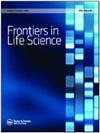Screening and optimization of γ-aminobutyric acid production from Monascus sanguineus under solid-state fermentation
Q1 Biochemistry, Genetics and Molecular Biology
引用次数: 29
Abstract
The aim of this study was to screen and optimize γ-aminobutyric acid (GABA) production from Monascus sanguineus. Different agro-waste residues were screened for GABA production. The GABA yield was confirmed by thin-layer chromatography and mass spectrometry. GABA was quantified using the simple ninhydrin protocol. Plackett–Burman and response surface methodology (RSM) as statistical tools were applied for screening and optimization of GABA yield. The accuracy of the RSM model was demonstrated by generating a non-statistical model using artificial neural network methodology. Coconut oil cake was the best substrate for GABA yield of all the tested substrates. Monosodium glutamate (MSG), pH and incubation period were found to favour GABA production. Maximum yield predicted from the RSM model was 15.53 mg/gds with an MSG concentration of 0.05 g at pH 7.5 and an incubation period of 20 days. This study considered an unexplored Monascus sp., M. sanguineus, which has primarily been used for pigment production. The capability of producing GABA from M. sanguineus using coconut oil cake as a substrate is an economical method with potential industrial use. The convincing results from this work could be considered as a benchmark for exploiting the Monascus strain to obtain GABA-enriched functional food for human consumption.血红曲霉固态发酵产γ-氨基丁酸的筛选与优化
本研究的目的是筛选和优化红曲霉产γ-氨基丁酸(GABA)。筛选了不同的农业废弃物残渣用于生产GABA。用薄层色谱和质谱法确定了GABA的产率。采用简单茚三酮法定量测定GABA。采用Plackett-Burman法和响应面法(RSM)对GABA产率进行筛选和优化。利用人工神经网络方法生成非统计模型,验证了RSM模型的准确性。在所有底物中,椰子油饼是GABA产率最高的底物。味精(MSG)、pH和孵育时间有利于GABA的产生。RSM模型预测的最高产量为15.53 mg/gds, pH为7.5,味精浓度为0.05 g,孵育期为20 d。本研究考虑了一种未开发的红曲霉sp., M. sanguineus,它主要用于色素生产。以椰子油饼为底物,从血柳中提取GABA是一种具有工业应用潜力的经济方法。这一令人信服的结果可作为开发红曲霉菌株以获得富含gaba的功能性食品供人类食用的基准。
本文章由计算机程序翻译,如有差异,请以英文原文为准。
求助全文
约1分钟内获得全文
求助全文
来源期刊

Frontiers in Life Science
MULTIDISCIPLINARY SCIENCES-
CiteScore
5.50
自引率
0.00%
发文量
0
期刊介绍:
Frontiers in Life Science publishes high quality and innovative research at the frontier of biology with an emphasis on interdisciplinary research. We particularly encourage manuscripts that lie at the interface of the life sciences and either the more quantitative sciences (including chemistry, physics, mathematics, and informatics) or the social sciences (philosophy, anthropology, sociology and epistemology). We believe that these various disciplines can all contribute to biological research and provide original insights to the most recurrent questions.
 求助内容:
求助内容: 应助结果提醒方式:
应助结果提醒方式:


